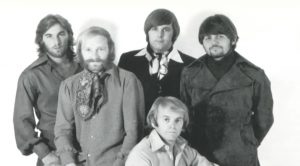Classic Rock Albums Turning 50 This 2024

via RushWire / Youtube
As the year 2024 unfolds, it’s not just any ordinary year for classic rock enthusiasts. It marks the 50th anniversary of some iconic albums that have stood the test of time. From legendary bands making their debuts to established artists exploring new sounds, 1974 was a remarkable year for music. Let’s take a nostalgic journey through the albums that defined that era.
1. Graham Nash, ‘Wild Tales’ (Jan. 2, 1974)
Graham Nash’s ‘Wild Tales’ set the tone for the year, reflecting a melancholy mood. Despite personal challenges, Nash delivered a collection of songs featuring notable contributors like Joni Mitchell and David Lindley.
2. Joni Mitchell, ‘Court and Spark’ (Jan. 17, 1974)
‘Court and Spark’ showcased Joni Mitchell’s fusion of folk-rock with jazz influences, earning her commercial success. The album, highlighted by the hit single “Help Me,” remains a cornerstone of Mitchell’s acclaimed discography.
3. Bob Dylan, ‘Planet Waves’ (Jan. 17, 1974)
Bob Dylan’s ‘Planet Waves’ marked a significant reunion with The Band after eight years. The album, featuring the timeless “Forever Young,” not only topped charts but also set the stage for Dylan’s return to the live scene.
4. Badfinger, ‘Badfinger’ (February 1974)
Badfinger’s self-titled album signaled a change, moving from Apple Records to Warner Brothers. Despite commercial challenges, the album showcased their musical prowess and humor.
5. Todd Rundgren, ‘Todd’ (February 1974)
Todd Rundgren’s ‘Todd’ revealed his creative restlessness, experimenting with various instruments and hallucinogenic influences. The album, including the fan-favorite “A Dream Goes on Forever,” captured Rundgren’s diverse musical palette.
6. Deep Purple, ‘Burn’ (Feb. 15, 1974)
Deep Purple’s ‘Burn’ introduced a revamped lineup, featuring David Coverdale and Glenn Hughes. The album marked a departure from their traditional hard rock, incorporating soul and funk elements.
7. Doobie Brothers, ‘What Were Once Vices Are Now Habits’ (Feb. 1, 1974)
The Doobie Brothers’ fourth studio album, ‘What Were Once Vices Are Now Habits,’ unexpectedly rose to prominence with the hit “Black Water.” Originally a B-side, the song became a No. 1 single and showcased the band’s versatility.
8. Kiss, ‘Kiss’ (Feb. 18, 1974)
Kiss’s eponymous debut introduced the world to Gene Simmons, Paul Stanley, Ace Frehley, and Peter Criss. Despite initial indifference, the album laid the foundation for Kiss’s iconic career.
9. Steely Dan, ‘Pretzel Logic’ (Feb. 20, 1974)
Steely Dan’s ‘Pretzel Logic’ saw the duo focusing on concise pop songs, yielding the hit “Rikki Don’t Lose That Number.” The album marked the end of an era as the band retired from touring.
10. Bob Seger, ‘Seven’ (March 1974)
‘Seven’ marked the debut of Bob Seger’s Silver Bullet Band and showcased his growth as a songwriter. The album, featuring tracks like “Get Out of Denver,” demonstrated Seger’s knack for memorable hooks.
11. Grand Funk Railroad, ‘Shinin’ On’ (Mar. 1, 1974)
Grand Funk Railroad’s ‘Shinin’ On,’ produced by Todd Rundgren, added two more Top 40 singles to their catalog. The album’s spontaneous cover of “The Locomotion” showcased the band’s ability to infuse party vibes into their sound.
12. Kansas, ‘Kansas’ (Mar. 8, 1974)
Don Kirshner introduced Kansas to the world with their self-titled debut. Despite humble beginnings, the album, featuring tracks like “Belexes” and “Apercu,” revealed the band’s potential in the progressive rock genre..
13. Rush, ‘Rush’ (Mar. 18, 1974)
Rush’s debut album, though born from a challenging process, featured the enduring “Working Man.” The blue-collar anthem set the tone for Rush’s illustrious 40-year touring history.
14. Eagles, ‘On the Border’ (Mar. 22, 1974)
Eagles shifted towards rock with ‘On the Border,’ produced by Bill Szymczyk. The album introduced new guitarist Don Felder and spawned hits like “Already Gone” and “Best of My Love.”
15. Lynyrd Skynyrd, ‘Second Helping’ (April 15, 1974)
Lynyrd Skynyrd’s ‘Second Helping’ elevated their Southern Rock profile with the anthem “Sweet Home Alabama.” The album showcased the songwriting prowess of Ed King, Allen Collins, and Gary Rossington.
16. Kinks, ‘Preservation Act 2’ (May 8, 1974)
The Kinks delved into theatrical storytelling with ‘Preservation Act 2.’ Despite mixed reviews, Ray Davies explored a more narrative side of songwriting, setting the stage for the band’s later work.
17. David Bowie, ‘Diamond Dogs’ (May 24, 1974)
‘Diamond Dogs’ marked David Bowie’s post-Spiders from Mars era. A commercial success, it influenced the punk genre, blending glam rock with funk and soul elements, foreshadowing his evolving musical journey.
18. Bad Company, ‘Bad Company’ (May 24, 1974)
Bad Company’s self-titled debut, released on Led Zeppelin’s Swan Song label, topped Billboard’s charts. With Paul Rodgers’ bluesy vocals, hits like “Can’t Get Enough” and “Movin’ On” became classics.
19. Grateful Dead, ‘From the Mars Hotel’ (June 27, 1974)
‘From the Mars Hotel’ added Dead classics like “U.S. Blues” and “Scarlet Begonias” to the band’s repertoire. It was their last studio album before a year-long touring hiatus.
20. Eric Clapton, ‘461 Ocean Boulevard’ (July 1974)
‘461 Ocean Boulevard’ marked Clapton’s return after battling heroin addiction. Covering blues classics, the album, featuring “I Shot the Sheriff” and “Let it Grow,” became an international success.
21. Neil Young, ‘On the Beach’ (July 19, 1974)
Neil Young’s ‘On the Beach,’ part of his “Ditch Trilogy,” delved into alienation and melancholy. Despite its commercial unavailability, it features beloved tracks like “Walk On” and “Revolution Blues.”
22. Bachman-Turner Overdrive, ‘Not Fragile’ (August 1974)
‘Not Fragile’ marked Bachman-Turner Overdrive’s commercial peak. Featuring hits like “Roll On Down the Highway” and “You Ain’t Seen Nothing Yet,” it became their first No. 1 album.
23. Jackson Browne, ‘Late for the Sky’ (Sept. 13, 1974)
Jackson Browne’s ‘Late for the Sky’ emerged from tight deadlines, becoming a modest success. Its title track found a place in Martin Scorsese’s Taxi Driver, solidifying its cultural impact.
24. Fleetwood Mac, ‘Heroes are Hard to Find’ (Sept. 13, 1974)
‘Heroes are Hard to Find’ marked the end of Fleetwood Mac’s turbulent chapter. Though it charted Top 40, changes were imminent, leading to the arrival of Lindsey Buckingham and Stevie Nicks.
25. John Lennon, ‘Walls and Bridges’ (Sep. 26, 1974)
John Lennon’s ‘Walls and Bridges’ reflected a period of separation from Yoko Ono. Successful singles like “Whatever Gets You Through the Night” showcased Lennon’s professionalism during a challenging time.
26. King Crimson, ‘Red’ (Oct. 1, 1974)
‘Red’ by King Crimson, despite a puzzlingly dim commercial reception, is now regarded as one of the heaviest albums of all time. The departure of the band shortly after set the stage for their reunion in 1981.
27. The Who, ‘Odds & Sods’ (Oct. 4, 1974)
‘Odds & Sods’ compiled stray tracks from The Who, offering a glimpse into unreleased material. Featuring future staples like “Long Live Rock” and “Naked Eye,” the album showcased the band’s prolific output.
28. Tom Waits, ‘The Heart of Saturday Night’ (Oct. 15, 1974)
Tom Waits’ ‘The Heart of Saturday Night’ paid homage to Jack Kerouac and Frank Sinatra. The album marked the beginning of a decade-long collaboration with producer Bones Howe.
29. Rolling Stones, “It’s Only Rock ‘n’ Roll’ (Oct. 18, 1974)
‘It’s Only Rock ‘n’ Roll’ signaled Mick Taylor’s departure and Ronnie Wood’s arrival. The title track, born from an epic jam, embodied The Glimmer Twins’ production style, paving the way for the Stones’ late ’70s sound.
30. Queen, ‘Queen II’ (Oct. 8, 1974)
Queen’s ‘Queen II’ showcased the band’s theatrical and progressive tendencies. The album’s “White Side” and “Black Side” concept laid the groundwork for their future multi-layered compositions.
31. Elton John, ‘Caribou’ (June 28, 1974)
Elton John’s ‘Caribou,’ named after the studio where it was recorded, featured hits like “Don’t Let the Sun Go Down on Me.” Despite mixed reviews, it continued his commercial success.
32. Frank Zappa, ‘Apostrophe (‘)’ (March 22, 1974)
‘Apostrophe (‘)’ by Frank Zappa marked a blend of comedy and virtuosic musicianship. The album’s centerpiece, “Don’t Eat the Yellow Snow,” became a radio hit.
33. Genesis, ‘The Lamb Lies Down on Broadway’ (Nov. 18, 1974)
‘The Lamb Lies Down on Broadway’ marked Peter Gabriel’s last studio album with Genesis. The ambitious double concept album is revered for its intricate storytelling and musical complexity.
34. Jethro Tull, ‘War Child’ (Oct. 14, 1974)
‘War Child’ by Jethro Tull continued their progressive rock legacy. The album, accompanied by a film, explored themes of war and the music industry, showcasing Ian Anderson’s eclectic songwriting.
35. George Harrison, ‘Dark Horse’ (Dec. 9, 1974)
George Harrison’s ‘Dark Horse,’ released on December 9, 1974, marked his first solo album post-Beatles that faced challenges in the British charts. The period surrounding the album was tumultuous for Harrison, involving legal disputes with former manager Allen Klein and the unraveling of his marriage.












